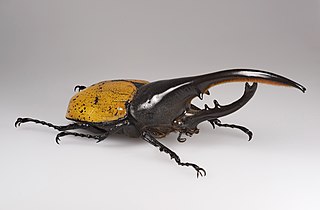
The Hercules beetle is a species of rhinoceros beetle native to the rainforests of southern Mexico, Central America, South America, and the Lesser Antilles. It is the longest extant species of beetle in the world, and is also one of the largest flying insects in the world.

Dynastes tityus, the eastern Hercules beetle, is a species of rhinoceros beetle native to the Eastern United States. The adult's elytra are green, gray or tan, with black markings, and the whole animal, including the male's horns, may reach 60 mm (2.4 in) in length. The larvae feed on decaying wood from various trees.
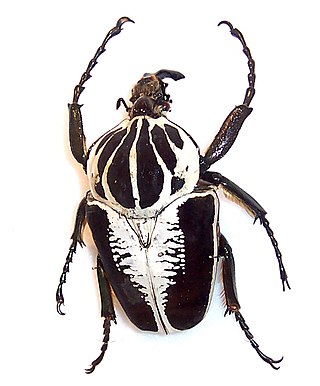
The Goliath beetles are any of the six species in the genus Goliathus. Goliath beetles are among the largest insects on Earth, if measured in terms of size, bulk and weight. They are members of subfamily Cetoniinae, within the family Scarabaeidae. Goliath beetles can be found in many of Africa's tropical forests, where they feed primarily on tree sap and fruit. Little appears to be known of the larval cycle in the wild, but in captivity, Goliathus beetles have been successfully reared from egg to adult using protein-rich foods such as commercial cat and dog food. Goliath beetles measure from 60–110 millimetres (2.4–4.3 in) for males and 50–80 millimetres (2.0–3.1 in) for females, as adults, and can reach weights of up to 80–100 grams (2.8–3.5 oz) in the larval stage, though the adults are only about half this weight. The females range from a dark chestnut brown to silky white, but the males are normally brown/white/black or black/white.

Cleridae are a family of beetles of the superfamily Cleroidea. They are commonly known as checkered beetles. The family Cleridae has a worldwide distribution, and a variety of habitats and feeding preferences.

Goliathus orientalis is a species of beetles belonging to the family Scarabaeidae.

Goliathus regius, the Royal Goliath beetle, is a species of beetles of the family Scarabaeidae.

Lasioderma serricorne, more commonly referred to as the cigarette beetle, cigar beetle, or tobacco beetle, is a small beetle that shares a remarkable resemblance with the drugstore beetle and the common furniture beetle. The cigarette beetle, along with the drugstore and furniture beetles, all belong to the Ptinidae beetle family. The cigarette beetle can be distinguished from A. punctatum by its flatter thorax, whereas the A. punctatum boasts a humped thorax. The cigarette beetle can be further differentiated from S. paniceum with its uniformly serrated antennae composed of 11 segments, unlike the three-segmented antennae of S. paniceum. Additionally, L. serricorne has more shallow grooves in its elytra, or hardened wing covers, compared to the A. punctatum and S. paniceum’s deep grooving.

Macrodactylus subspinosus is a North American beetle of the family Scarabaeidae. The members of its genus are known as "rose chafers", not to be confused with the European rose chafer, Cetonia aurata. M. subspinosus occurs from Eastern Canada to Colorado and is considered a pest of many crops and flowers. It is given its common name of rose chafer because it eats the leaves of roses, although it also feeds on many other plants.
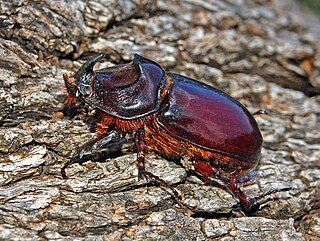
The European rhinoceros beetle is a large flying beetle belonging to the subfamily Dynastinae.

Clytus arietis, the wasp beetle, is a wasp-mimicking longhorn beetle species in the genus Clytus.

Eudicella gralli, sometimes called the flamboyant flower beetle or striped love beetle, is a brightly coloured member of the scarab beetle family, in the subfamily known as flower beetles. Their shells seem to have a prismatic quality, refracting the ambient light to give the green of their carapace a rainbow tint. This species of flower beetle lives in the rainforests of Africa, where it feeds on the nectar and pollen of flowers, but is popular in the exotic pet trade. The larvae of the flower beetle live in decaying wood, feeding on dead wood and leaf litter. Adults reach lengths of 25–40 millimetres (0.98–1.57 in). As in other species of this genus, the males have a Y-shaped horn, used to fight over females. The females have a shovel-like tusk, used for burrowing in wood. During their gestation period they will dig into the wood and lay eggs.

Philaenus spumarius, the meadow froghopper or meadow spittlebug, is a species of insect belonging to the spittlebug family Aphrophoridae. In Italy and America, it is economically important as one of the vectors of Pierce's disease.

The western Hercules beetle is a species of rhinoceros beetle that lives in Arizona, New Mexico and Utah in the United States and in parts of northern Mexico. This species is known for its grayish-white elytra, large size, and characteristic horn of the adult males.
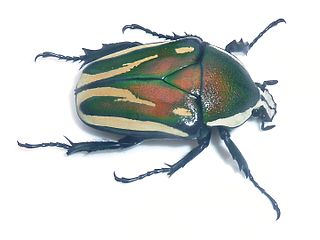
Dicronorhina derbyana, or Derby's flower beetle, is a sub-Saharan species of flower chafer.
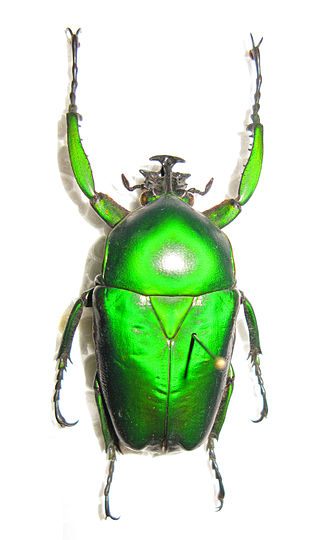
Dicronorhina micans is a species of beetle of the family Scarabaeidae and subfamily Cetoniinae. It is native to the African tropics.

Eudicella loricata is an insect of the scarab beetle family, in the subfamily known as flower beetles.
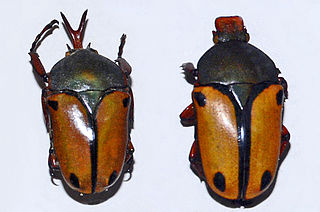
Eudicella smithii is a species of African scarab beetle in the subfamily Cetoniinae, the flower beetles.

Calopteron discrepans, the banded net-winged beetle, is a species of net-winged beetle in the family Lycidae. It is found in North America.

Meloe americanus is a type of blister beetle (Meloidae) found in North America. It is most relevant to the fields of agriculture and veterinary medicine. Adult beetles feed on different types of plants, which cause crop damage. They also release a fluid containing a chemical that is toxic, and at high concentrations lethal, to mammals. The first instar larvae are uniquely active and mobile, utilizing phoresy and parasitism to feed and mature through their developmental stages.

Rivacindela hudsoni is an Australian species of the family Cicindelinae or "tiger beetle" and is the fastest running insect. The genus Rivacindela is contentiously treated as a subgenus of the broader Cicindela and are typically found in salty habitats such as dry salt lakes and salt streams. The species was discovered in South Australia and described in 1997, with an adult form of approximately 20–21mm in length and a running speed of 2.49 m/s, or 120 body lengths per second.




















